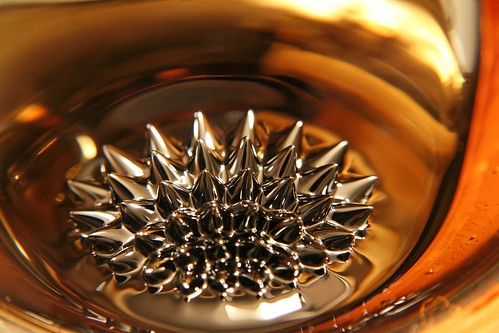
Ferrofluid 3, originalmente cargada por AMagill.
A ferrofluid (from the Latin ferrum, meaning iron) is a liquid which becomes strongly polarised in the presence of a magnetic field. It is a colloidal mixture comprising extremely small magnetic particles suspended in a liquid. The particles are coated with a soap or detergent to prevent them from clumping together.
Ferrofluids are composed of nanoscale ferromagnetic, or ferrimagnetic, particles suspended in a carrier fluid, usually an organic solvent or water. The ferromagnetic nano-particles are coated with a surfactant to prevent their agglomeration (due to van der Waals and magnetic forces). Although the name may suggest otherwise, ferrofluids do not display ferromagnetism, since they do not retain magnetization in the absence of an externally applied field. In fact, ferrofluids display (bulk-scale) paramagnetism, and are often referred as being "superparamagnetic" due to their large magnetic susceptibility. Permanently magnetized fluids are difficult to create at present.
It is important to note the difference between ferrofluids and magnetorheological fluids (MR fluids). The particles in a ferrofluid primarily consist of nanoparticles which are suspended by Brownian motion and generally will not settle under normal conditions. MR fluid particles primarily consist of micron-scale particles which are too heavy for Brownian motion to keep them suspended, and thus will settle over time due to the inherent density difference between the particle and its carrier fluid. These two fluids have very different applications as a result.
Ferrofluids are composed of nanoscale particles (diameter usually 10 nanometers or less) of magnetite, hematite or some other compound containing iron. This is small enough for thermal agitation to disperse them evenly within a carrier fluid, and for them to contribute to the overall magnetic response of the fluid. This is analogous to the way that the ions in an aqueous paramagnetic salt solution (such as an aqueous solution of copper(II) sulfate or manganese(II) chloride) make the solution paramagnetic.True ferrofluids are stable. This means that the solid particles do not agglomerate or phase separate even in extremely strong magnetic fields. However, the surfactant tends to break down over time (a few years), and eventually the nano-particles will agglomerate, and they will separate out and no longer contribute to the fluid's magnetic response. The term magnetorheological fluid (MRF) refers to liquids similar to ferrofluids (FF) that solidify in the presence of a magnetic field. Magnetorheological fluids have micrometre scale magnetic particles that are one to three orders of magnitude larger than those of ferrofluids.
However, ferrofluids lose their magnetic properties at sufficiently high temperatures, known as the curie temperature. The specific temperature required varies depending on the specific compounds used for the nano-particles, surfactant, and carrier fluid.




